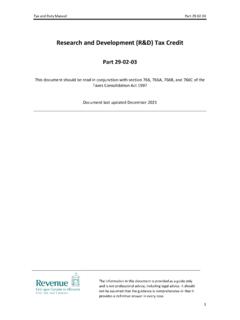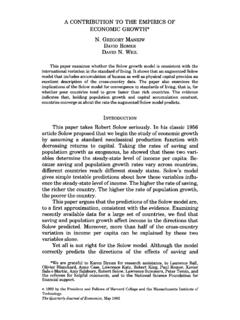Transcription of NASA Socio-Economic Impacts
1 NASA Socio-Economic Impacts April 2013 This report was prepared for NASA by Table of Contents Contents Executive Summary..i Introduction ..1 Snapshot of NASA s Budget..1 How Does NASA Impact the Economy and Society?..2 NASA Invests in Technology and Industry..3 Much of NASA s Budget Goes to Technology..3 NASA Programs Invest in a Broad Range of Technology Areas..4 NASA s Technology Investments Provide Potential Earth Applications..5 NASA s Engages Manufacturing NASA Contributes to Global Emerging Technologies ..7 NASA Contributes to National Science and Technology Priorities.
2 9 Input/Output Modeling Shows NASA s Spending Has Bigger Transactional Impacts than the Federal Average ..9 NASA Spurs Innovation and Business Growth .. 11 NASA Uses Multiple Pathways to Commercialize Innovations ..11 NASA Creates and Transfers Thousands of Technologies Annually ..12 NASA Innovations May Generate $1 Million in Revenue for Each Spinoff ..12 NASA Advances Space-related Industries ..14 NASA s Contribution to the Weather Industry..14 NASA Promotes Collaboration and Supports Foreign Policy .. 17 NASA s Space Act Agreements Promote Collaboration and NASA s International Agreements Support Foreign Policy.
3 18 NASA Leverages Interest in Science and Technology .. 19 NASA Motivates Participation in Science and Technology Challenges ..19 NASA Involves Citizen Scientists in its Missions ..19 NASA Inspires People Around the World ..21 NASA Inspires Widespread Interest ..21 NASA Generates New Scientific Knowledge ..23 NASA is a Widely Respected Source of Scientific Information ..23 NASA Trains and Engages the Next Generation of Scientists and Engineers..24 Conclusion..26 NASA ImpactsThis page intentionally left blank Executive Summary Executive Summary This report characterizes Socio-Economic Impacts to the nation from NASA investments as it pursues its vision and mission.
4 The report is based on a study identifying objective, concrete measures reflecting NASA s wide range of Impacts . NASA s expenditures ripple throughout the economy, supporting critical industries, creating new businesses and jobs, and attracting students to science and engineering. NASA invests in technologies and discoveries for the future, and in the process, it delivers social and economic Impacts that benefit the nation today. No single metric can capture the returns from NASA s activities, given their many dimensions. This report organizes NASA s Socio-Economic Impacts into six categories and highlights important outcomes in each one.
5 Leverages Interest in Science and Technology Promotes Collaboration and Supports Foreign Policy Advances Space-Related Industries Spurs Innovation and Business Growth Invests in Technology and Industry Inspires People Around the World NASA s benefits extend far beyond NASA Impacts 80% of NASA 2012 budget to programs $5B on manufacturing $300M on key emerging technologies $2B on science and tech priorities Bigger transactional impact than fed avg Invests in Technology and Industry NASA expenditures contribute to competitively important areas: technology, manufacturing, businesses, and universities.
6 NASA invests in economically valuable technologies that help the nation maintain its competitive advantage. NASA spends nearly half its budget on manufacturing industries; the White House identifies manufacturing as vital to re-invigorating the economy. NASA also spends hundreds of millions of dollars on developing emerging technologies, and billions advancing science and technologies identified as key national priorities. About 80 percent of NASA activities are carried out by businesses and universities, with 20 percent supported by NASA employees. This business model of relying on capabilities and expertise across the country helps NASA achieve its goals and benefits the nation s economy by creating larger ripples throughout the economy than other federal agencies on average.
7 1,600 new technologies reported in 2012 2,200 tech transfer transactions in 2012 $1M annually per spinoff (median, based on small study) Spurs Innovation and Business Growth NASA transfers its unique knowledge, products, services, and processes. While NASA captures highlights of about 50 technology transfers to industry in its annual Spinoff publication, it develops more than 1,600 new technologies each year and transfers thousands of products, services, and processes. These transfers help businesses generate revenue and create jobs. Satellite telecommunications Satellite navigation Remote sensing Space access Advances Space-Related Industries NASA advances globally important, space-related industries.
8 Since its creation in 1958, NASA has contributed to the advancement of space-related industries that have a broad impact on our daily lives. NASA has made major contributions to world-changing industries like satellite telecommunications, GPS, remote sensing, and space access. NASA s contributions have enabled the first weather imagery to be transmitted from space, deployment of the first geosynchronous satellite, and human access beyond low Earth orbit. ii Executive Summary 500 agreements, 2/3 of world s countries 2,000 Space Act Agreements with ~500 companies and other partners Promotes Collaboration and Supports Foreign Policy NASA s promotes collaboration with and international partners.
9 NASA s international agreements strengthen foreign policy by supporting National Security Strategy goals for collaborative research and development. Hundreds of companies, universities, and other government agencies engage with NASA through thousands of Space Act Agreements. These agreements let NASA and its partners formalize arrangements for access to expertise, facilities, and resources. In some cases, the agreements serve as alternative contracting mechanisms to develop new capabilities cooperatively. 5,000 individuals, 100 corporate teams participated in citizen scientists from ~80 countries Leverages Interest in Science and Technology NASA involves individuals and companies in volunteer science and technology research (challenges, citizen scientists).
10 NASA involves over a million individuals and hundreds of companies in volunteer science and technology research endeavors, through research collaborations, crowd-sourcing projects, and science and technology prizes. These volunteer efforts generate new ideas, technology, and scientific data for the Agency, and increase awareness and capability in science and technology for many people. 12M Twitter followers 1B visits/downloads of NASA datasets, 2012 refs in academic articles (10 years) 60M annual views of education websites 8,000 applicants for internship (2011) Inspires People Around the World NASA s public visibility and shared data inspires people around the world.















